

Blue Mountains Tourism & Travel
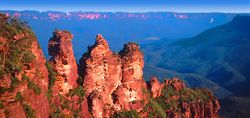
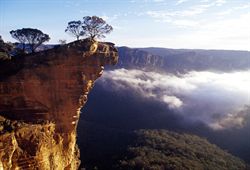
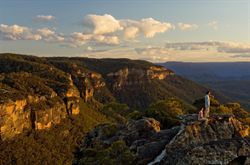
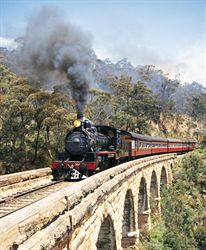
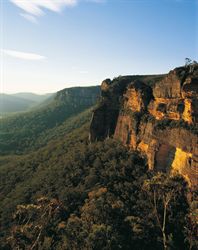
Blue Mountains Australia
The Blue Mountains do in fact appear blue - a unique mountainous panorama. The dense forests of eucalypt trees release droplets of oil that cause the blue light rays of the sun to be scattered more effectively. This intensifies the usual light refraction and results in mountains that appear blue from a distance.
Blue Mountains National Park
The Blue Mountains National Park can be reached just over 50 kilometres, 30 miles west of Sydney. Waterfalls and cascades look silver as they glide and tumble over sandstone ledges into pools surrounded by ferns and mosses. Narrow gullies protect pockets of warm temperate rainforest filled with ferns, mosses and vines. The elegant, superb lyrebird, golden whistler, satin bowerbird and rufous fantail all live in the wet forests. Along the creek banks platypus, water-dragons and skinks are often seen.
Blue Mountain Heritage Centre
The Heritage Centre in Blackheath, which presents the geological, Aboriginal and European histories of the region, is the best place to start exploration. One walking track extends to Govetts Leap Lookout where the view of the Grose Valley and Bridal Veil Waterfall is one of the Blue Mountains greatest sights.
The Three Sisters
A spectacular rock formation known as the Three Sisters is the result of erosion. Aboriginal legend has is that the rock is in fact three sisters, imprisoned by their father to protect them from a bunyip.
Blue Mountain Scenic Skyway
The Scenic Skyway is Australias only horizontal cable ride. The cable car takes passengers 350 metres, 382.8 yards across a deep gorge suspended from a cable 226 metres, 247.2 yards above the Jamison Valley.
As the cable car passes Orphan Rock, passengers are nearly close enough to throw a stone onto this large single sandstone monolith. Another legend says Orphan Rock is the Witchdoctor from the Dreamtime looking after his three beautiful daughters, who are located on a cliff edge on the opposite side of the valley.
Experience breath-taking views of the Three Sisters, Mount Solitary, the Ruined Castle and Katoomba Falls. The return journey includes a pause in mid-air near the Cliff View Lookout, adjacent to the eastern anchorage, where on windy days passengers can feel the spray from the spectacular Katoomba Falls.
Sceniscender Aerial Tramway
A new aerial tramway called the Sceniscender has been added to the original Railway and Skyway. After leaving the top station the aerial tram drops steeply over the edge of a 100-metre, 109.4 yard cliff, travels 554 metres, 605.9 yards then rests on the rainforest floor of the Jamison Valley.
The lower station of the Sceniscender is joined to the bottom platform of the Scenic Railway by two boardwalks. One is accessible by wheelchairs, and the other continues to a deeper part of the valley, providing an experience of unparalleled rainforest beauty, passing points of historic and botanical interest.
Blue Mountain History
Around 450 million years ago when Australias eastern coastline was further inland, coral atolls developed around a series of partially submerged volcanoes, the coral became compressed and developed into Australias most spectacular limestone caves.
James McKeown, an escaped convict and bushranger is the first white man known to have entered the caves, using them as a hideaway.
The caves were given their name - Jenolan - in 1884, which, in the local Aboriginal language means high mountain. Visits to the cave after they became known began with candles in holders. Today, electricity lights the amazing limestone formations, pools and rivers. Of the 300 subterranean chambers that make up Jenolan, nine are open to the public.
The town of Wentworth Falls was named after William Charles Wentworth, who, along with two other farmers, Gregory Blaxland and William Lawson successfully found a way to get to the western side of the Blue Mountains after many others had failed. Nearby is a rugged waterfall also known as Wentworth Falls. This waterfall is evidence of a massive slip in the escarpment and pockets of rainforest thrive along its edges.
Red Hands Cave hosts some well-preserved examples of hand stencils by the Dharug people that are believed to be between 500 and 1600 years old - a privilege to witness. The images on the cave wall were made using the hand as a stencil and blowing a spray of ochre from the mouth.




